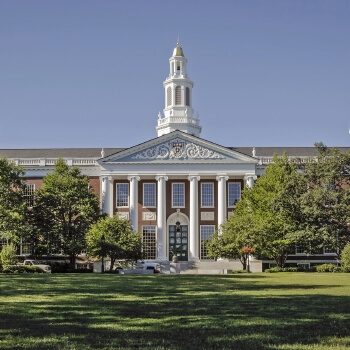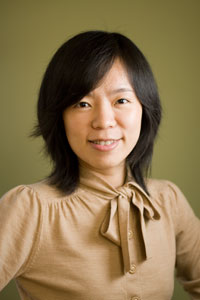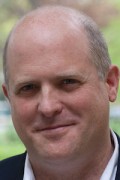News
Faculty from SEAS and HBS discussed the potential for collaboration during a joint research symposium held at the business school campus in Allston. (Photo provided by the Harvard Business School.)
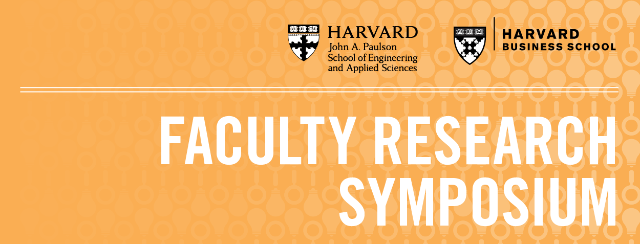
No matter how many brilliant thinkers a company may employ in-house, sometimes the most innovative solution to a problem can be found from seeking answers outside–from the crowd.
“Crowds appear to reliably produce cheaper, faster, and better solutions than internal efforts for elite institutions,” said Harvard Business School Associate Professor of Business Administration Karim R. Lakhani.
Lakhani was among presenters at a joint Faculty Research Symposium held May 12 on the HBS campus as an opportunity for faculty from the two schools to highlight a variety of research findings to an audience of doctoral students, staff members, and other professors. The event was one of a series designed to explore opportunities for collaboration ahead of the expansion of the SEAS campus to a new complex across the street from the business school in a few years.
The event was one of a series designed to explore opportunities for collaboration ahead of the expansion of the SEAS campus to a new complex across the street from the business school in a few years.
Seeking answers from the crowd
In sharing the results of his research on crowdsourcing, Lakhani said the question comes down to this: Do we have the right labor force?
His research team recently held a three-week-long contest that looked to improve the accuracy and processing speed of an algorithm designed to analyze genomic data. With a prize pool of $20,000, the contest drew quite a bit of attention; 96 people submitted 410 programs, and 20 of the contestants had ideas that exceeded researchers’ expectations. The best solution increased the accuracy of the data from 91 percent to 97 percent and increased processing speed 15 times over.
Such competitions show that organizations can often find better solutions through crowdsourcing—inviting experts in various fields to work on complicated problems and provide fresh ideas, Lakhani said.
And those crowds don’t necessarily have to be huge, either. “We can find high-performing solutions from as little as 22 crowd members,” he said.
Crowdsourcing isn’t exactly new. Lakhani, who is the Principal Investigator of the Crowd Innovation Lab and NASA Tournament Lab at the Harvard Institute for Quantitative Social Science, pointed out that the HBS campus was actually designed through a contest in the 1920s, with 200 plans submitted.
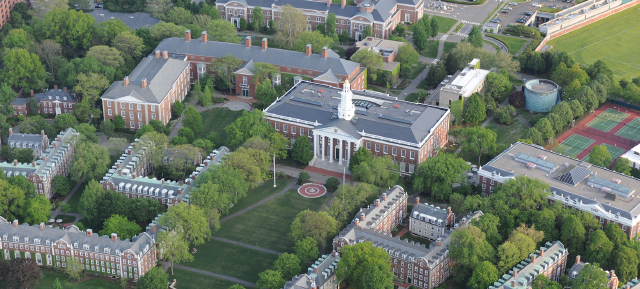
A bird's-eye view of the Harvard Business School campus. (Photo by Gren Hren for Harvard Business School.)
Seeking answers from the crowd may be more important than ever. Even as the use of data science is expanding, we face a shortage of 1.8 million data scientists.
“There’s a lot of competition for data science talent,” Lakhani said, with medical schools, social companies, and other industries all looking to hire.
Holding contests to seek advice from the crowd may help companies fill the need for innovative answers more cheaply and quickly.
“Contests create incentives and drive parallel search,” Lakhani said. “What you want when you care about innovation is the extreme value. You don’t want average value. (Contests) allow me to find the extreme value.”
Soft wearable robots improve mobility
In the Harvard Biodesign Lab, Conor J. Walsh, the John L. Loeb Associate Professor of Engineering and Applied Sciences at SEAS, is working on creating soft wearable robots, lightweight equipment that is strapped to the body to help increase mobility for people who are physically impaired due to stroke, multiple sclerosis, or other ailments.
More than 80 percent of stroke survivors live with residual gait impairments, and helping patients in clinics involves manual, labor-intensive work.
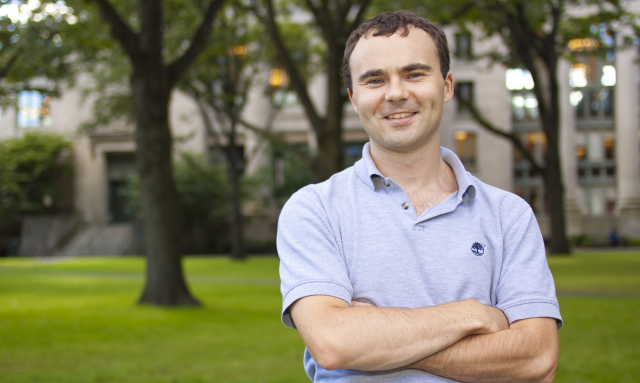
Conor J. Walsh, the John L. Loeb Associate Professor of Engineering and Applied Sciences at SEAS, spoke about his work creating soft wearable robots during the symposium. (Photo by Eliza Grinnell/SEAS Communications.)
The lab is not only developing equipment that helps people walk faster and with more stability, it is designing soft robotic gloves that aid with upper extremity issues. A patient with a spinal cord injury may use the glove to pinch fingers together, making lifting a glass easier. Future work will focus on using sensors that respond to a person’s muscle movements.
“It’s an area [that] technology should be able to help,” Walsh said. It’s not quite what is portrayed in movies such as Iron Man, where ordinary people are given superhuman strength. “From an engineering point of view, this is extremely hard … Soft wearable robots don’t give people superhuman strength. But they give them the boost they need to be more active and independent.”
Curbing the patent trolls
Another research presentation focused on the adverse effects around patent litigation, which has increased sharply in the last decade.
In fact, 2015 saw one of the highest patent lawsuit counts ever. Most of these suits are being brought by nonpracticing entities (NPEs), firms that don’t actually generate products, but collect massive amounts of patent portfolios. Lauren H. Cohen, the L.E. Simmons Professor in the Finance Unit at HBS, said evidence shows NPEs act as “patent trolls,” suing cash-rich firms for alleged patent violations, and it seems they do so regardless of whether patents were infringed on or not.
NPEs are well aware that with intellectual property, the idea space is nebulous—which can lead to ambiguity that needs to be judged by courts. But for a firm targeted by NPEs, taking a dispute to court can be an expensive proposition.
All of this litigation has a wearing effect on its victims: It ends up stifling innovation activity at the targeted firms.
“Targeted firms that lose to NPEs invest significantly less in research and development going forward,” Cohen said.
Congress has considered more than a dozen bills that seek to control patent trolling by slamming companies that are found to be initiating frivolous suits with higher fees after the fact. But for a targeted firm, by that time the damage has already been done, especially when a costly court battle drags on for months.
“If you’re a small, innovative firm, you don’t have that kind of time. Your technology will be obsolete,” Cohen said.
Cohen said it makes sense to set up an “advance screening mechanism,” a low-cost litigation review board made up of a panel of judges that could provide an initial review to cases within three to six months to determine whether the cases have any merit. No matter the decision, a company could still pursue litigation, but that panel decision would follow the case.
“We need to fight patent trolling up front and weed out patent trolling lawsuits early in the process,” Cohen said. “(A review board) would screen out good NPEs from bad NPEs.”
A social computing design
Yiling Chen, Gordon McKay Professor of Computer Science at SEAS, talked about social computing, where human creativity is used to accomplish computational tasks. Chen, a faculty affiliate at the Center for Research on Computation and Society, is interested in analyzing and designing social computing systems to meet economic goals.
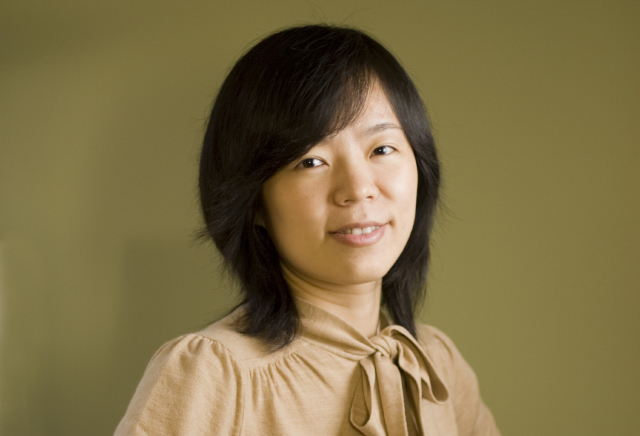
Yiling Chen, Gordon McKay Professor of Computer Science at SEAS, discussed social computing during the symposium. (Photo by Eliza Grinnell/SEAS Communications.)
With regard to the interaction of humans with machines, Chen asked: When thinking about social computing, how can we ensure we get the output we want to get?
For example, in the case of automated markets, if a trader wants to purchase a bundle of shares, the market should tell the trader how much to pay. “We should think about how we can design interactions to achieve system-wide goals in social computing,” she said.
Existing collaborations
About two-thirds of SEAS is moving to Allston, across the Charles River from its current location in Cambridge, in 2020. The move will make it a close neighbor of HBS, and there’s hope the proximity will encourage more collaboration.

The new Science and Engineering Complex in Allston will house about two-thirds of SEAS students and faculty when it opens in 2020. (Rendering courtesy of Behnisch Architekten.)
To that end, the symposium featured an afternoon panel of faculty who are already involved in cross-Harvard collaboration: Daniel Schrag, Sturgis Hooper Professor of Geology, Professor and Area Dean for Environmental Science and Engineering at SEAS, and Director of the Harvard University Center for the Environment; Forest Reinhardt, John D. Black Professor of Business Administration at HBS and co-chair of the School’s Global Energy Seminar; Daniel J. Needleman, Gordon McKay Professor of Applied Physics at SEAS; and Vicki Sato, who servers both as Professor of Management Practice at HBS and an affiliate member of the Department of Molecular and Cell Biology at Harvard.
About two-thirds of SEAS is moving to Allston, across the Charles River from its current location in Cambridge, in 2020. The move will make it a close neighbor of HBS, and there’s hope the proximity will encourage more collaboration.
Sato oversees the Blavatnik Fellowship in Life Sciences Entrepreneurship, which provides a select group of HBS MBA alumni the opportunity to work with top Harvard inventors. The goal: to promote the commercialization of promising life science technologies. The program includes projects that have received funding from the Blavatnik Biomedical Accelerator Fund. Needleman received funding from the accelerator last year for a project that involves the success rate of assisted reproductive technologies such as in-vitro fertilization.
Asked about potential obstacles to collaboration between HBS and SEAS, Needleman cited inevitable culture clashes between hard-science researchers and market-minded MBA grads. “One thing that I found interesting was that communication can be challenging, both in terms of style and vocabulary,” said Needleman. “On the other hand, by spending time with each other, those can be overcome.”
The panelists also discussed the possibility of collaborating on teaching methods. For instance, some SEAS classes could adopt HBS’s case method of teaching, in which students generally do 85 percent of the talking and the professor serves more as guide than lecturer.
“Science depends on discussion,” Sato said. “I think there’s a tremendous opportunity for expanding the pedagogy across the university.”
The panel wrapped up with a discussion about what the relationship between SEAS and HBS might look like a decade from now, and how to measure collaborative success. Several audience members weighed in, including HBS Dean Nitin Nohria.
“My real dream is that we should build in Allston a company like Google or Facebook,” Nohria said. “Yes, I celebrate the fact that we might have all these great small things [happening], but we do need one big win to come out of this collaboration. We need some kind of signal that makes the world notice that there’s something important going on between SEAS and Harvard Business School.”
Cutting-edge science delivered direct to your inbox.
Join the Harvard SEAS mailing list.
Scientist Profiles
Yiling Chen
Gordon McKay Professor of Computer Science
Daniel P. Schrag
Sturgis Hooper Professor of Geology and Professor of Environmental Science and Engineering
Press Contact
Paul Karoff
